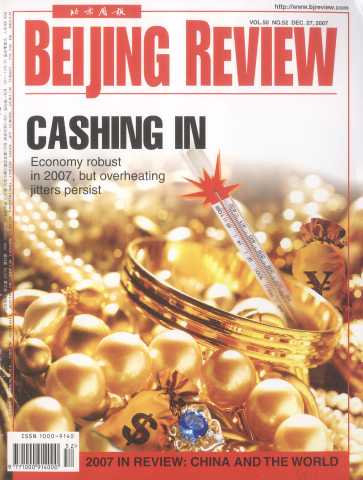How to coexist with a China growing in economic power and more active in world affairs? David Gosset, Director of the Academia Sinica Europaea, China Europe International Business School, Shanghai, and founder of the Euro-China Forum, provides his analysis based on his long-term engagement with this fast-changing nation. Following are excerpts of an article published by Gosset on Asia Times Online:
The Quattrocento refers to the 15th-century Italian Renaissance; ershiyi shiji - 21st century in Mandarin - can be used as a reference to the current Chinese renaissance and the way it is changing our world.
Arguably the most significant process of our time, China's renaissance is composed of three interrelated elements: economic reemergence, socio-political transformation and intellectual reinterpre-tation of the Chinese tradition.
After the 17th National Congress of the Communist Party of China in October, and before the 2008 Beijing Olympics and the 2010 Shanghai World Expo, not one single day goes by without news, debates and comments on China; confronting such a profusion, one risks taking short-term variations or trivial fluctuations for long-term tendencies and losing any sense of pattern.
One question can help us focus on what really matters: Are Westerners ready to adjust to the effects of the Chinese renaissance? In other words, is the West prepared for a century with Chinese characteristics, is it ready for the ershiyi shijil
Understanding the China factor
Fourteen years after the collapse of the Qing Dynasty (1644-1911), writer Lu Xun was asking in his essays: "When are we going to stop bringing new bricks to the Great Wall?" A defensive construction built and consolidated through the centuries to protect the empire from the invasions of nomads, the Great Wall could also be seen as the symbol of an immured Chinese mind. In 1949, China fully recovered its sovereignty; in 1978, Beijing adopted the opening-up policy - today, the Great Wall is a tourist attraction.
In a process of unprecedented magnitude, one fifth of mankind, different from the West, is entering the world stage. While Western scientific and economic modernity will continue to have influence on China-Beijing's overall strategic goal is modernization - the Chinese world will have considerable quantitative and qualitative impacts on the global village.
To look at China without passion requires constant intellectual vigilance. One has to avoid the idealizations of the Sinophile or the demonizations of the Sinophobe.
True, the People's Republic of China is a developing country that is, as such, facing considerable challenges. If one focuses exclusively on what has yet to be done to catch up with the developed world or on the various visible signs of Westernization within China, the idea of serious Chinese influence on the global village can appear illusory.
However, if one considers the scope of post-imperial China's metamorphosis (the collapse of the Roman Empire in the 5th century was followed by at least 300 years of disorder in Western Europe), the speed of its transformation since 1978, while keeping in mind the Chinese empire's past cultural, economic and political centrality in Asia, the question of the Sinicization of the world makes sense.
The presupposition of the "China threat" leitmotiv is precisely China's capacity to influence on a massive scale our world system, but it also assumes that this impact will be negative. Between two extremes, "China fever" and "China threat," the analyst should stay rationally within the limits of what can be called the "China factor": China's opening-up means, to a certain extent, Sinicization of the world, a process that has to be integrated and explained and not adored or condemned a priori.
Modernization does not mean cultural alienation
But how could the global citizen be in any way Sinicized if tomorrow's China is radically Westernized?
Looking at the young people in Dalian, Beijing, Shanghai, Shenzhen or Chongqing, it seems that Westernization is China's future. It gives Chinese students "face" to speak some English - more "face" if it is American English. On campus they practice sports popular in the West, and after graduation they would opt preferably for a career in a joint venture where the corporate culture is supposed to be Western - and the pay higher.
But it is necessary to put these trends into historical perspective. In China, snapshots can be misleading. One has to integrate different "clocks" and be attentive, behind shorter developments or even ephemeral fashions, to very slow movements, what Fernand Braudel called the longue durée.
Past interactions between China and what was foreign to it show the unique resilience of Chinese civilization. It has the ability to change without losing itself; it could even be defined by this singular capacity of renewal.
The Yuan Dynasty (1277-1367) and the Qing Dynasty (1644-1911) were established respectively by Mongols and Manchus. However, the only way for the "barbarians" - non-Han - to rule the empire was to adopt elements of the Chinese tradition. Immutable China is a myth- the long history of China is a succession of clearly distinct periods-but absolute discontinuity from one time to another is also a narrative.
Buddhism and Christianity have also been testing Chinese civilization's capacity to absorb exogenous elements. Entering under the Han Dynasty (Eastern Han, 25-220), Buddhism penetrated deeply into the Chinese world under the Tang Dynasty (618-907); but this penetration has seen the transformation of original Buddhism to fit Chinese philosophical and linguistic context.
In the age of European expansion, Christian missionaries spared no effort to convert Chinese people. The Jesuits' approach initiated by Matteo Ricci (1552-1610) was to engage as much as possible with China's elites; no one has ever understood the Chinese world better than the Sinologists of the Company of Jesus, but genuine European intellectual excellence failed to change radically the Chinese mind. How can one seriously believe that current superficial material Westernization in China - related to food or clothes, the introduction of managerial skills, the instrumental use of English, etc-is going to affect essentially Chinese culture?
China's technical and economic modernization does not mean cultural alienation. China is once again translating into its own context foreign practices and theories. Democratization might be unavoidable for the Chinese world - in fact, the process has already begun - but it will be a democratization with high Chinese characteristics, a very fortunate process indeed. One should remember the words of Alexis de Tocqueville (18P5-1859) in Democracy in America: "I am well aware of the influence which the nature of a country and its political precedents exercise upon a constitution; and I should regard it as a great misfortune for mankind if liberty were to exist all over the world under the same forms."

FOR WORLD PEACE: Chinese peacekeepers in Haiti are awarded medals for their dedication to world peace. As China grows stronger, it plays a more active role in world affairs to fulfill its own obligations as a world stakeholder
Some external forms of the translation process can be a surprising accumulation of heterogeneous pieces. Look at a Sichuan-cuisine restaurant with Rococo furniture or at a Shanghai middle-class home where reproductions of European impressionists coexist on the same wall with Chinese calligraphy. The sociologist observing China's megasociety can interpret these unusual combinations as parts of a gigantic assimilation. One can also enjoy completed translations where the "original" fits perfectly into the evolving Chinese context; it is often the case in architecture, in ur-banism or in design.
The resilience of Chinese culture cannot be separated from China's demographic vitality; they reinforce each other in what constitutes a virtuous circle. The very fact that China is the most populous country in the world is highly significant.
In the global community, fundamentally optimistic and life-oriented China will interact with various Western forms of nihilism; the culture of life and happiness will quietly prevail.
China and globalization
China absorbs, translates and regenerates itself vigorously. In 2005, Chinese people from Singapore to Beijing celebrated the 600th anniversary of the navigator Zheng He's (1371-1433) first voyage. These celebrations of the Ming Dynasty explorer, Asia's Christopher Columbus, were also indicative of China's current mindset: Chinese people can also be extrovert and do not intend to witness passively, beyond the Great Wall, the reconfiguration of the world.
China's direct investment overseas is rising rapidly. By the end of 2006, China made $75 billion direct investment in more than 160 countries. The 2008 Beijing Summer Olympics and the 2010 Shanghai World Expo will reinforce this momentum.
The Chinese world is not only made up of China's mainland, Hong Kong, Macao, Taiwan and the highly Sinicized Singapore, but also includes in its largest extension a Chinese diaspora active worldwide.
This diaspora - estimated at 50 million people - is not just about Chinese restaurants (although food and cooking are key elements of culture) or Chinatowns (perfect examples of Chinese cultural resilience far away from the Yellow River or the Yangtze River); the notion of Chinese diaspora indicates that China is not only a political entity related to a territory but, above all, a cultural expression already having global reach. Those who know Mandarin and, more importantly, written Chinese, those who can play by the codes of the Chinese culture, have, in fact, access to a network whose main hubs are in the Mainland and at its periphery but which is certainly not limited by traditional borders. The "sinosphere" is not only a transnational domain ideally structured to benefit from "a flat world" but also an accelerator of globalization.
Co-architect of the 21st-century new world order?
For the West, adjustment to China's renaissance requires modesty and intellectual curiosity. Are Westerners ready to learn from the Chinese civilization as Chinese people are ready to learn from the West? This is the precondition of a genuinely cooperative relationship. Seriously engaging China is to accept the very possibility of Sinicization.
The West, in a position of scientific and economic superiority since the industrial revolution, is used to treating China as a product of orientalism. For the majority of Westerners, China is either a museum - hence the surprise of many foreigners in China: "I was expecting something else!" - or a classroom: One has to lecture Chinese people on more advanced standards. The West has to reflect on these prejudices and to look at China as a living matrix of a civilization that is already reshaping our time.
If China proves to be an integrating factor in a world plagued by morally unacceptable, exclusive globalization, if China proves to be a laboratory where cultures can cross-fertilize in a world threatened by tensions between civilizations, one should rejoice to find a co-architect of the 21 st-century new world order and to live at the very beginning of the ershiyi shiji.


 Copy Reference
Copy Reference